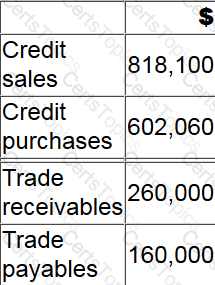Statements of financial position as at 31 December 20X8 for JK, LM and PQ are as follows:

[1] JK purchased 80% of LM's $1 equity shares on 1 January 20X8 for $260,000 when the retained earnings of JK were $110,000. At that date the non-controlling interest had a fair value of $63,000.
[2] JK purchased 25% of PQ's $1 equity shares on 1 January 20X8 for $90,000 when the retained earnings of PQ were $96,000.
[3] During the year JK sold goods to LM for $32,000 at a mark up of 33.33% on cost. Half of the goods were still in LM's inventory at 31 December 20X8.
[4] LM transferred $32,000 to JK on 30 December 20X8 in settlement of the inter-group trade. JK did not record the cash in its financial records until 2 January 20X9.
Calculate the value of inventory that would be included in JK's consolidated statement of financial position at 31 December 20X8.
Give your answer to the nearest $.
An entity has a working capital cycle of 120 days which has been calculated in part from the following data:

What is the stock holding period on the basis of 365 days in a year?
Give your answer to the nearest whole day.
BCD owns an item of plant which cost $20,000 and at the time of purchase was assessed to have a useful economic life of 8 years and a residual value of $2,000
The carrying amount of the plant at 1 January 20X8 is $11,000. On that date BCD's directors estimate that the plant's remaining useful life is now 6 years The residual value remains unchanged at $2,000
What is the depreciation charge for this plant for the year ended 31 December 20X8?
Give your answer to the nearest $.

For an incorporated business, the taxation of trading income is a form of direct taxation which is based on: